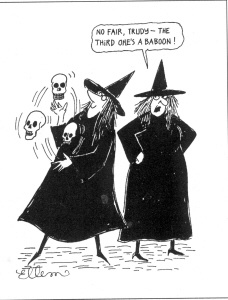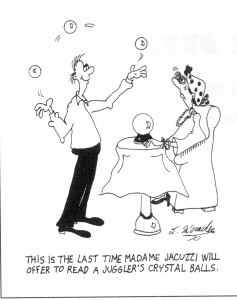
"No fair, Trudy - the third one's a baboon!" |

"This is the last time Madame Jacuzzi will offer to read a juggler's crystal ball." |
Page 22 Spring 1995
|
Stunning Starts and Fancy Finishes for Club Jugglers by Doug Dougal. Published by Circustuff in 1994. ISBN 0 9520300 6 3. 72 pages, soft cover. Available in Europe from the publisher for 6 pounds 50, in North America from Infinite Illusions and in Australasia from More Balls Than Most in New Zealand.
The
back cover of this book entices people with the words, "OK, so
you can juggle three
clubs. But what next?"
It answers the question by saying that the reader could spend years learning complex tricks, or buy the book and in "a deceptively short time" impress friends with the simple flourishes, thumb rolls, kickups and other tricks explained in its pages. You still have to learn them, of course, but it's true that the tricks in "Stunning Starts and Fancy Finishes" carry a high rate of applause per practice hour.
This
book includes several dozen "cutesy" club moves that you can
use at the beginning, middle or end of a routine. Veteran jugglers
will be familiar with the majority of the moves described,
For
newcomers, it's a broad and valuable encyclopedia of largely
tried-and-true moves to help build a performance repertoire, including
multiplexes, kickups, flourishes, scissors catches and a thorough
explanation of the pirouette.
The
tone throughout is folksy and lighthearted, demonstrating that
author Doug Dougal is definitely in it for the fun. For example, in
describing the "Crown of Thorns," he writes, "Not as
painful as the name implies. This is due mainly to the complete
absence of thorns required to do it. In fact, 'hat of clubs' would be
a more apt name. Less dramatic, though, so Crown of Thorns it
is."
With
95 illustrations and sparse text, the layout is clear and inviting.
The cartoony pen-andink juggling character complements the
lighthearted tone of the text. The illustrations are clear and
instructional, however, whether drawn in full body form, or as
close-ups of the hand and club to help the reader learn
The Diabolo Book. By Todd Strong. Published in the US 1994 by Brian Dube. 90 pages, soft cover. ISBN 0-917643-10-0. $14.95 plus s &: h.
Todd
Strong's "The Diabolo Book" should serve as a model for
everyone interested
It's
overwhelmingly just the facts - the facts of how to learn diabolo
manipulation from ground zero to complex tricks, and the fascinating
facts of its fairly well documented history..
Strong's
writing style is clear and to the point, splashed with enough
appropriate humor and author's personal comments to give the book
personality. Good writing rises or falls on the artwork that supports
it, and this book stands tall because of its attractive line drawings,
photos of contemporary artists doing diabolo, reproductions of
turnof-the-century diabolo post cards and fourcolor soft cover.
The clean layout and ample illustrations make it fun to keep turning
through its 90 pages.
The
heart of the book, as the author states, is the "tricks"
section. He presents about 45 tricks in the order that most people
learn them, beginning with throws and catches and advancing all the
way to two diabolos. Dozens of simple, realistic pen and ink drawings
of the author performing the trick, or closeups of the stick and
string arrangement, clarify the associated text.
A
subsequent short section describes passing, steals and pass-alongs
with a partner.
However,
the thing that really sets this instruction book apart from others is
Strong's extensive essay on the history of the diabolo. The author
takes appropriate credit for helping popularize the diabolo with this
generation of jugglers, but from the beginning of his involvement with
the diabolo in 1980 it has been for him a scholarly pursuit as well as
a physical one. The book originally began as Strong's master's thesis,
and he lists more than a dozen libraries at which he conducted
research during the course of its writing. His teaching credits
include appointments at the Die Etage school in Berlin and at the
Centre National des Arts due Cirque in France. The weight of this
academic research and Strong's years of experience as a teacher give
the book an authority not found in most juggling books.
Though
no skill or prop can be traced to an absolute beginning, Strong makes
a good case for the origin of the diabolo in ancient China. His
research uncovered interesting stories of its appearance in Europe in
about 1790, brought back from the Orient by statesmen and traders. He
digresses at that point into a discussion of the Chinese and Greek
etymology of the word "diabolo" that should establish
once and for all how the name came to be.
The
history of the prop continues through its use as a rich persons toy in
the early 1800s, then as a national passion in France in the early
1900s, complete with local clubs, tournaments and a team lawn game
similar to tennis.
The diabolo's third Western renaissance has been spurred in the past decade by jugglers adding it to the inventory of their manipulative skills. The appearance of Strong's comprehensive and attractive book puts the art on a high pedestal this time around!
Cigar Box of Tricks. By Shaun Clark. Published 1994 by Circustuff, 83 Vist Rd.; Pitcoune; Glenrothes; Fife UK. ISBN 0-9520300-3-9. (Available in the US from Brian Dube.)
There
are precious few resources for learning cigar box tricks, and Shaun
Clark has done a good job of compiling a valuable encyclopedia for
aficionados of this particular manipulative skill.
The
135-page book includes 66 differently named tricks with three boxes,
and about 10 with four boxes - plenty enough to build a highly
respectable repertoire. He wastes no words on introductory material.
Instead, a single page tells the reader to find a set of good boxes
and get to work! The rest of the book is tricks, tricks, tricks. It
begins with simple moves and advances logically through sections on
stacking, vertical tricks, contacts, combinations, cross section,
starts and finishes, body moves, flourishes and pirouettes
Most
of each page is covered with illustrations of the tricks. They are
plain and simple, but clearly show the flight direction of boxes and
movement of hands. The skeletal fingers are ghoulish, but Clark
reasonably explains that they show how the boxes are held between
finger joints. Following the explanation of most tricks the author
lists suggested - but non-illustrated - variations of them.
The writing is clear and concise most of the time, but gets too "cutesy" occasionally ("Moral is - if you stumble or fumble, don't grumble, be humble - mega groan!"). That, however, is a minor point that doesn't affect the overall value of the work. It's an excellent resource for those interested in this highly visual, and physically demanding, art form. |

"No fair, Trudy - the third one's a baboon!" |

"This is the last time Madame Jacuzzi will offer to read a juggler's crystal ball." |